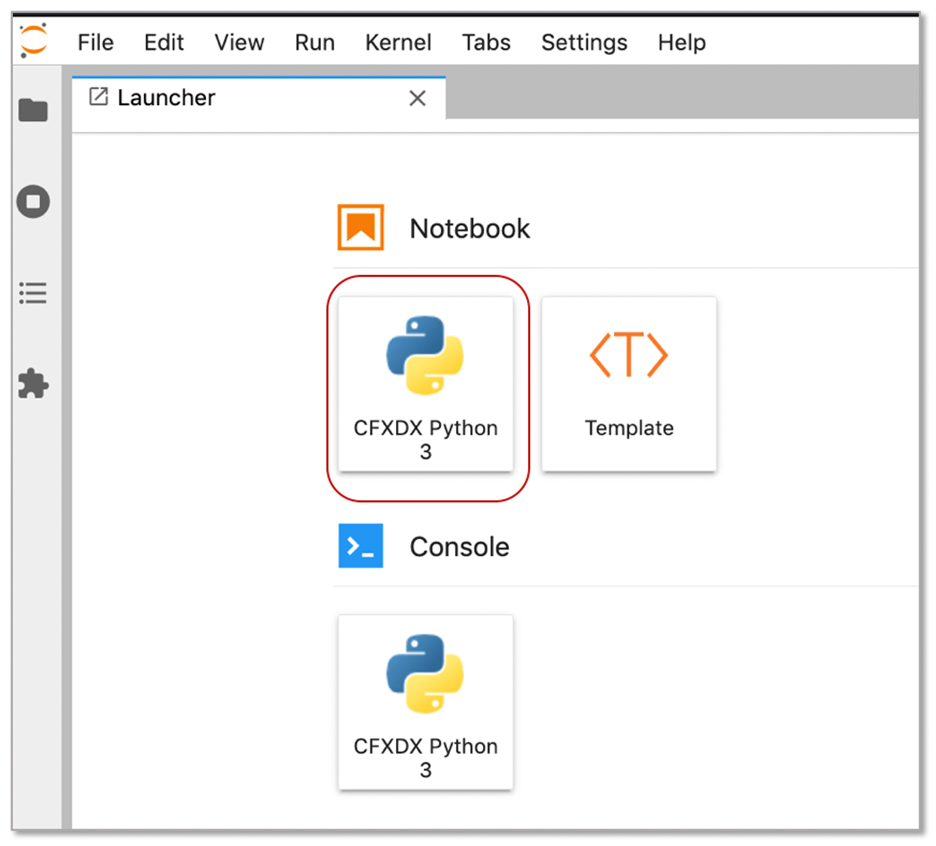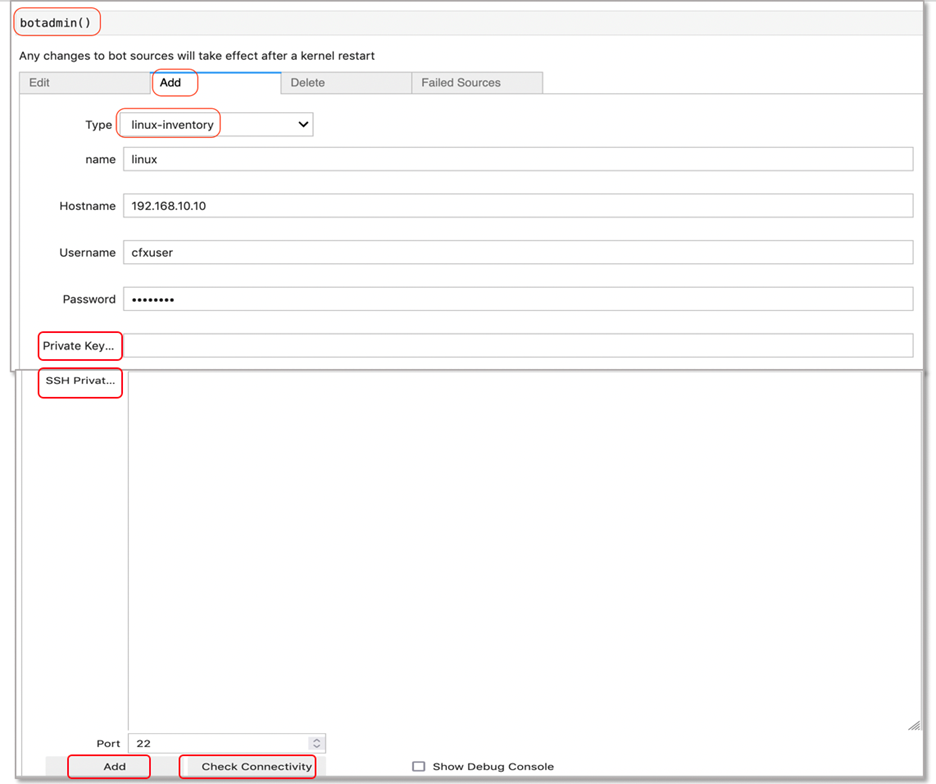Linux OS
CloudFabrix RDA provides out of the box agent-less integration for inventory data collection from Linux server OS editions using SSH protocol. Using this integration, inventory data like Linux OS version, server make & model, running services and processes and TCP/UDP network connections will be collected.
Using RDA's integration with Linux Server OS, below are the two primary use cases that are supported and consumed within the CloudFabrix Asset Intelligence and AIOps platforms.
-
Linux Server OS inventory &
-
Application Dependency
1. Prerequisites:
Linux OS inventory
Supported Linux server OS distributions are, CentOS, RHEL and Ubuntu. SSH user account that is used to connect and collect the data should have sudo privileges for the below commands.
- dmidecode
- netstat
- ss
- service
- dpkg
- rpm
- nsenter**
- docker ps**
- docker ps -a**
- docker inspect**
**Applicable only for docker container environments
On CentOS, RHEL & Ubuntu, edit /etc/sudoers file and add the above commands for the user account that is used for data collection.
<user_name> ALL=(root) NOPASSWD: /usr/sbin/dmidecode,/usr/bin/netstat,/usr/sbin/ss,/usr/bin/nsenter,/usr/bin/docker ps *,/usr/bin/docker inspect *,/usr/bin/docker top *,/sbin/service --status-all,dpkg -s,rpm -qai
Note
In some of the Linux OS versions, above commands may be under /bin directory instead of /usr/bin, please verify the location path of these commands and configure them appropriately in /etc/sudoers file.
Below are the list of commands are executed to collect the inventory data using bots.
Tip
command block is executed first to collect the inventory data. If command block fails, it will execute fallback block
Bot system-info:
command = ["sudo /usr/sbin/dmidecode -t 1",
"hostnamectl",
"grep MemTotal /proc/meminfo",
"lscpu",
"/bin/hostname",
"cat /etc/redhat-release"]
fallback = ["/usr/sbin/dmidecode -t 1",
"hostnamectl",
"grep MemTotal /proc/meminfo",
"lscpu",
"/bin/hostname",
"cat /etc/redhat-release"]
Bot network-config:
Bot netstat:
Bot disks:
command = "/bin/lsblk --pairs --bytes -o name,type,mountpoint,fstype,model,label,size,vendor,serial,wwn,uuid,state"
Bot disk-usage:
Bot services:
command = "systemctl --type=service --state=active,inactive"
fallback = "sudo /sbin/service --status-all"
Bot processes:
Bot software-packages:
command = {
"Ubuntu": "dpkg -s",
"default": "rpm -qai"
}
fallback = {
"Ubuntu": "sudo dpkg -s",
"default": "sudo rpm -qai"
}
Bot docker-containers:
Bot docker-netstat:
command = '''for i in `docker ps --format {{.ID}}`;
do echo ++++++++++++;
echo Container ID: $i;
echo PID: $(docker inspect -f '{{.State.Pid}}' $i);
echo Name: $(docker inspect -f '{{.Name}}' $i);
sudo nsenter -t $(docker inspect -f '{{.State.Pid}}' $i) -n netstat -natup;
done'''
fallback = '''for i in `sudo docker ps --format {{.ID}}`;
do echo ++++++++++++;
echo Container ID: $i;
echo PID: $(sudo docker inspect -f '{{.State.Pid}}' $i);
echo Name: $(sudo docker inspect -f '{{.Name}}' $i);
sudo nsenter -t $(sudo docker inspect -f '{{.State.Pid}}' $i) -n netstat -natup;
done'''
Bot docker-network:
command = '''for i in `docker ps --format {{.ID}}`;
do echo ++++++++++++;
echo Container ID: $i;
echo PID: $(docker inspect -f '{{.State.Pid}}' $i);
echo Name: $(docker inspect -f '{{.Name}}' $i);
sudo nsenter -t $(docker inspect -f '{{.State.Pid}}' $i) -n ip a s;
done'''
fallback = '''for i in `sudo docker ps --format {{.ID}}`;
do echo ++++++++++++;
echo Container ID: $i;
echo PID: $(sudo docker inspect -f '{{.State.Pid}}' $i);
echo Name: $(sudo docker inspect -f '{{.Name}}' $i);
sudo nsenter -t $(sudo docker inspect -f '{{.State.Pid}}' $i) -n ip a s;
done'''
Bot docker-processes:
command = '''for i in `docker ps --format {{.ID}}`;
do echo ++++++++++++;
echo Container ID: $i;
docker top $i;
done'''
fallback = '''for i in `sudo docker ps --format {{.ID}}`;
do echo ++++++++++++;
echo Container ID: $i;
sudo docker top $i;
done'''
Test SSH Connection with CLI access:
To verify the SSH configuration, use ssh command which helps to test the remote connection to target Linux server over SSH protocol and an ability to execute a command.
2. Adding Linux OS as Datasource/Extension in 'RDA':
Linux OS or any other datasource/extension's configuration is configured in RDA's user interface. Login into RDA's user interface using a browser.
https://[rda-ip-address]:9998
Under Notebook, click on CFXDX Python 3 box

In the Notebook command box, type botadmin() and alt (or option) + Enter to open datasource administration menu.
Click on Add menu and under Type drop down, select linux-inventory

- Type: Datasource/Extension type. In this context, it is linux-inventory
- name: Datasource/Extension label which should be unique within the RDA
- Hostname: IP Address / DNS name of Linux host
- Username: Linux username
- Password: Linux password
- Private Key Passphrase: SSH private key passphrase (optional)
- SSH Private Key: SSH private key (optional)
- Port: 22
Note
Hostname field is only used for a quick network access and authentication access check against any one of the valid Linux server host while adding the linux-inventory as a datasource. For actual data collection from Linux servers, it expects IP or IP subnet range as an input during runtime. Please refer the following sections for an example.
Click on Check Connectivity to verify the network access and credentials. Once it is validated, click on Add button to add the linux-inventory as a datasource.
3. Linux OS data exploration in RDA Studio:
Once Linux OS integration details are configured in RDA as a datasource, it will be ready to connect to targe Linux servers and explore the data for the analysis.
For the details on Linux OS inventory data collection bots, refer CloudFabrix RDA Bot Documentation